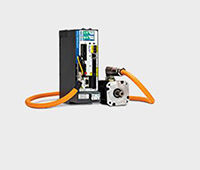Steel producers worldwide continually refine their processes to serve the changing needs of their customers. For example, Federal emission standards and consumers demand more efficient vehicles without compromising performance and styling. In response, steel producers have begun to develop thinner, lighter weight auto gage steels that perform as well and look better than previous materials. However, producing a specialty steel cost effectively is always challenging, particularly when incorporating new alloy technology that is designed to be stronger yet lighter than previous steels. These thinner steels are much more sensitive to surface damage from vibrations of rotating mill rolls.

Americarden Model U3440 units feature 553,000 Nm torque capacity, special carburized steels and custom bearing steel rollers.
To reduce the damage caused by vibration, operators often reduce the speed of their mills by up to 20%, which reduces production. That 20% production reduction can equate to one 20-ton coil of steel per hour that would have had a $50/ton profit, which would have delivered a $24,000 profit.
Thus, the financial losses associated with steel surface damage due to mill vibration can be significant. To understand why mill operators are eager to convert to U-joints, consider the following example: Surface-critical exposed prime steel sells for approximately $850/ton. If the surface is marred or damaged, the steel is downgraded to secondary, non-exposed usage with a 20% ($170/ton) reduction in price. Typical annual cold mill production is around 3 mil tons. If only 2% of the product is downgraded, that equates to 60,000 tons. So, 60,000 tons minus $170/ton yields a total annual loss of a staggering $10.2 mil.
One steel producer was experiencing excessive wear and vibration of the gear spindles on their 5-stand tandem cold mill with various spindle brands lasting only six months. Two spindles on each mill stand connect the pinion gearboxes to the primary upper and lower work rolls that compress the steel in a cold condition. Over time the surface damage to the steel from the spindle vibration (chatter) caused the operator to either slow the mill down, reducing production by 20% to reduce the vibration, or replace the spindles completely. The motor drives a gear box that connects to the pinion stand single input shaft. The u-joints connect the two pinion stand outputs to the work rolls that roll the steel sheet.
That’s why Ameridrives Power Transmission was called to provide a more reliable spindle. Soon after, Ameridrives’ application engineers approached the mill with a new idea. They recommended that all the gear spindles be converted to universal joints, which would reduce surface damaging vibration almost completely, while allowing the mill to run at faster speeds. After testing competitive models, the mill selected Americardan Model U3440 universal joints. The mill was then able to run at record-setting production levels with reduced vibration and minimal related surface damage. The new U-joints reduced lubrication manpower, lube and clean-up costs by approximately $120,000 annually compared to a grease lubricated gear spindle on a 5-stand mill.

These graphs illustrate the reduction in vibration before and after using the Americarden universal joints.
Ameridrives engineers work closely with steel mill operators around the world to replace their cold mill gear spindles, which amplify vibration, as they drive the work rolls on the mill stands.
Americardan universal joints operate at high misalignment angles up to 15° and are suitable for use in severe atmospheric conditions. Through materials and tight tolerances, the universal joints have proven to reduce vibration levels in rolling mills. Universal joint design features include closed eye one-piece yokes, replaceable inner race bearing package, zero radial clearance bearing package and built-in spring packs on the roll end knuckle.
Spring packs are non-contacting in operation and are only engaged during roll change. You can mate the spline adapters to the gear spindle at the pinion end. This approach can be used without removing the adapter, which speeds installation. These units can be interchanged with any gear spindle in any mill stand, in top or bottom position, at any time.
Altra Industrial Motion
altracouplings.com
Filed Under: Factory automation, Gears • gearheads • speed reducers, MOTION CONTROL, MORE INDUSTRIES





Tell Us What You Think!